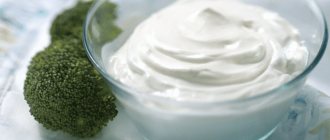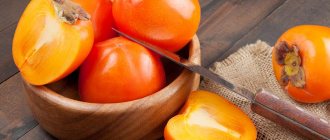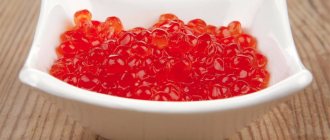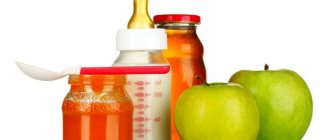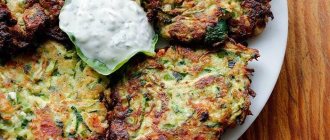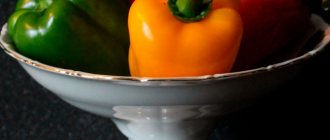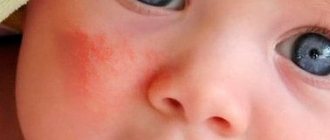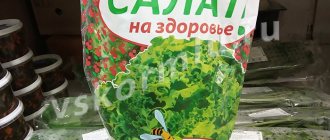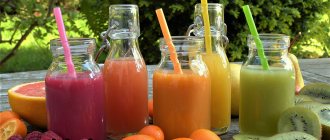The ideal food for a baby is breast milk, which contains all the necessary proteins, minerals and vitamins. But the mother’s diet must be specially selected, since many foods can cause allergies or colic in a newborn. Women quickly get bored with boiled chicken and buckwheat, so they want to somehow diversify their diet. One of the popular questions is whether squash caviar is suitable for breastfeeding? Let's look at this issue in more detail.
Nutrition during lactation
An important point is the quality of breast milk; in fact, its benefits depend on it. The amount of protein in breast milk does not change depending on the foods consumed, because it is compensated by the mother’s body reserves. But minerals, trace elements, fats and vitamins must be replenished by proper nutrition of a woman.
Reasonably selected products will prevent hair loss and dullness, tooth decay, loss of skin elasticity, and improve overall well-being and appearance. A well-thought-out diet will allow you to put a young mother’s figure in order without gaining weight due to empty and unnecessary calories.
Zucchini is a source of vitamins and microelements. It is safe for babies, as it does not disturb digestion and does not cause allergies. The vegetable is suitable not only for the mother’s diet, but also for feeding babies aged 6 months and older.
Zucchini is suitable for consumption boiled or stewed. After heat treatment, this vegetable does not have a strong taste, so it can be combined with other ingredients. Squash caviar is a completely acceptable product during lactation, so mothers can safely prepare this healthy and tasty dish.
Composition of zucchini
The product has low calorie content, making it suitable for dietary nutrition. Nutritional value of 100 g of zucchini - 24 kcal. Young mothers who are overweight can take note of these properties of the product.

Despite the minimal amount of calories, zucchini contains a lot of useful substances. It contains vitamins A, C, B, K, PP, fiber and minerals (magnesium, iron, potassium, calcium).
The main effects of squash caviar on the body

Zucchini caviar is a combination of vegetables such as carrots, onions, tomatoes and zucchini or zucchini itself. To make the dish more spicy, add sugar, ground black pepper, vinegar, salt and vegetable oil.
The value of vegetable snacks is in their high concentration of fiber, which allows you to:
- improve digestion;
- normalize intestinal motility, thus eliminating constipation after childbirth;
- increase metabolism, promoting weight loss;
- remove bad cholesterol;
- increase the elasticity of blood vessels;
- remove excess fluid from the mother’s body, reducing puffiness and getting rid of bags under the eyes.
How to prepare the vegetable
In the first 2-3 months of a newborn’s life, it is not recommended to include zucchini in a woman’s diet. It is best to introduce them to the menu after three months of age. Zucchini can be subjected to the following heat treatment: boiled, baked or stewed.
The best option is vegetable stew. Acceptable ingredients include: zucchini, cauliflower, potatoes and carrots. These vegetables can be included in the diet of a nursing mother in small quantities.
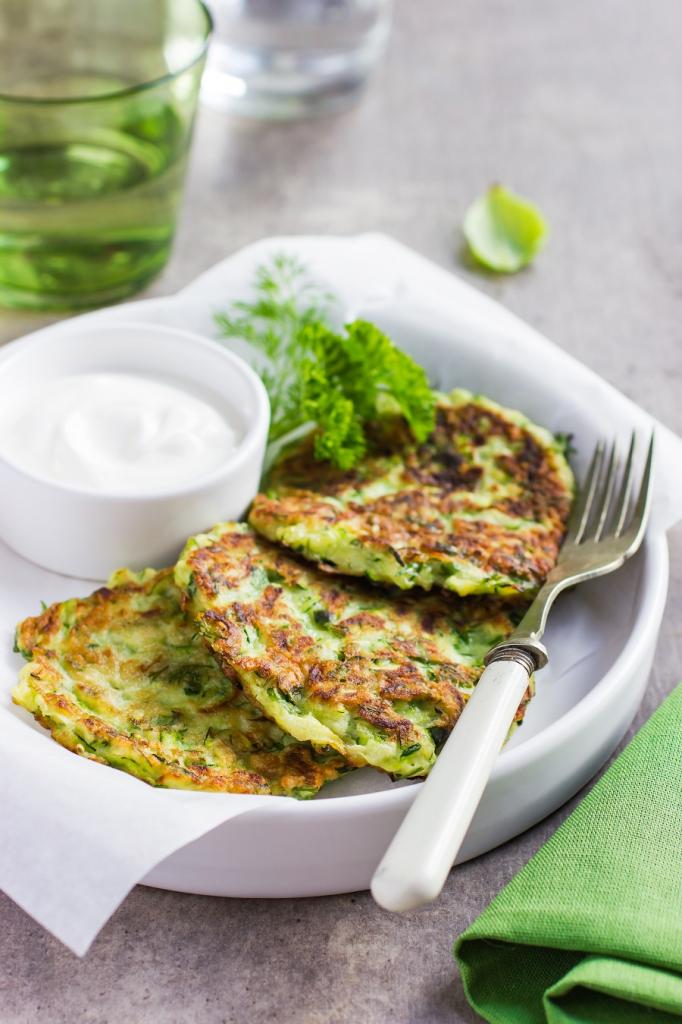
It is very useful to cook zucchini in a double boiler. With this processing, it retains all its nutrients. They will pass into breast milk and then to the baby.
A delicious dish - baked zucchini. It can be cooked together with new potatoes in their skins. Occasionally the zucchini is fried in a frying pan. This is not as useful, but it can add variety to the menu.
Breastfeeding women will enjoy zucchini pancakes. This dish is particularly beneficial.
There is a simple recipe for squash caviar. The dish can be used as an addition to side dishes. The best option is to prepare the caviar yourself. Therefore, it will not contain harmful chemical components that will negatively affect the baby’s body.
Benefits for mother and child
During breastfeeding, squash caviar allows you to saturate not only milk with essential macro- and microelements, but also restore a woman’s body, which is depleted during pregnancy and childbirth.
All vegetables, zucchini, onions, carrots and tomatoes, contain:

- Vitamin C, which protects against infections, improves the immunity of both baby and mother. Promotes the absorption of iron to prevent anemia. Vitamin C is necessary for the growth and restoration of vascular cells, gums, teeth and bones;
- B vitamins have a positive effect on the emotional state of a breastfeeding mother. Sleepless nights, hormonal changes, postpartum depression and stress make the mother exhausted and do not allow her to fully enjoy motherhood. By focusing your diet on foods rich in B vitamins, all these symptoms will go away, because a happy mother means a happy child;
- Vitamin A and beta-carotene help improve vision and are an antioxidant, protecting against infections;
- calcium strengthens the skeletal system, which is important for both the baby and the mother;
- magnesium eliminates swelling in the body,
- potassium and sodium are necessary for the functioning of the heart muscle;
- phosphorus is important for the formation of the baby’s skeleton and musculoskeletal system.
By the way, you shouldn’t throw away the zucchini peels. You can make a face mask from this vegetable. This procedure will perfectly cleanse pores, improve color and promote skin rejuvenation.
Squash caviar during breastfeeding: a dietary recipe
Every woman during breastfeeding has to carefully choose products. After all, her menu also determines the baby’s diet. Some foods are not suitable for a child and can cause bloating and allergies.
True, many women sometimes have concerns even about simple and familiar products. Is it possible to eat squash caviar while breastfeeding?
The article will discuss the properties of the vegetable, its advantages and disadvantages.
Composition of zucchini
The product has low calorie content, making it suitable for dietary nutrition. Nutritional value of 100 g of zucchini - 24 kcal. Young mothers who are overweight can take note of these properties of the product.
Despite the minimal amount of calories, zucchini contains a lot of useful substances. It contains vitamins A, C, B, K, PP, fiber and minerals (magnesium, iron, potassium, calcium).
Beneficial features
Zucchini has beneficial properties for the female body. Thanks to them, your complexion will improve, rashes will disappear, and your skin will become more elastic and firm.
Zucchini is a source of vitamins and nutrients. With constant consumption of vegetables, the immune system is strengthened. After all, this is what a woman lacks after pregnancy and childbirth.
The vegetable will help you lose weight. Zucchini is low in calories. It quickly saturates the body, perfectly suppressing the feeling of hunger.
Zucchini ensures the normal functioning of the nervous system. After all, many women during this period suffer from postpartum depression, lack of sleep and stress. Squash caviar during breastfeeding will help restore psycho-emotional stability. The product is able to normalize blood pressure.
Zucchini has diuretic properties. This will be useful for women who suffer from edema. After all, diuretics are prohibited, but this vegetable will come to the rescue.
Squash caviar contains fiber, which will help cleanse the body of toxins and waste. With their help, women can get rid of constipation.
Magnesium in the vegetable has a positive effect on the functioning of the heart and blood vessels.
Harm to vegetables
Despite the benefits of squash caviar, it also has some negative properties. Therefore, it is not recommended to take this product continuously. Zucchini caviar is a powerful diuretic. The product is able to remove from the body, in addition to harmful substances, vital elements (potassium). Its deficiency can lead to heart failure and other pathologies.
Squash caviar during breastfeeding can cause the following health problems:
- the appearance of pain in the epigastric region, which is caused by the acid contained in raw vegetables;
- the occurrence of diarrhea in a woman, and bloating and intestinal colic in a baby;
- The occurrence of allergic reactions is associated with the consumption of low-quality vegetables.
Such side effects usually occur with excessive consumption of zucchini. The optimal dose that a woman can eat is 200-300 g of vegetables per day. Zucchini should be included in the diet no more than 3 times a week.
Caviar can weaken your baby's tummy and lead to colic. And other components, such as peppers, tomatoes, carrots, can cause an allergic reaction. Therefore, caviar components should be introduced into the diet gradually so that the child gets used to them.
How to choose the right zucchini
A woman during breastfeeding approaches the issue of selecting products for her diet with maximum responsibility. The main thing in this case is to purchase quality vegetables.
When choosing zucchini, pay attention to the following characteristics:
- Peel. It should be elastic and smooth. Dark spots, rot and mold are not allowed on the surface of the peel.
- The color varies from light green to rich green. If the zucchini has a yellow tint, it may be frozen.
- The size of the vegetable should not exceed 25-30 cm. These fruits are the healthiest and highest quality, because large ones contain a lot of seeds.
In the summer, it is best for women to consume zucchini from their own plots or purchase them at the market from summer residents. Such vegetables usually contain a minimum of nitrates and other harmful substances.
How to introduce it into your diet
When breastfeeding, squash caviar should be introduced into the diet gradually. Therefore, the following rules must be followed:
- the optimal time for inclusion in the diet is 10-14 days;
- It is preferable to stew or boil vegetables;
- squash caviar is allowed only if the child is not allergic to this product;
- It is recommended to experiment with various vegetable dishes after 2.5-3 months, when the baby’s body is completely stronger;
- Only dietary squash caviar should be included in the menu (tomatoes can be excluded);
- It is not recommended to overuse vegetables, despite their beneficial composition.
Before preparing zucchini dishes, it must be thoroughly washed and scalded with boiling water.
Is it possible for nursing mothers to have squash caviar?
During lactation, women are especially careful when choosing their diet. Many of them ask whether it is possible to eat squash caviar while breastfeeding. Experts see nothing wrong with this product.
When cooked, squash caviar retains all its beneficial properties. It also contains carrots, onions, and bell peppers. This set of components will have only a beneficial effect on the body of the mother and baby.
Caviar will have a positive effect on the digestive system due to its fiber content.
In order to include squash caviar in your diet without fear, you need to take into account several nuances. Ideally, the dish should be prepared at home.
This reduces the likelihood of low-quality ingredients getting into food. It is best to prepare caviar from boiled vegetables rather than fried ones.
This dish will retain a lot of useful substances and vitamins, and it will be easier for the digestive system of mother and child to digest it.
If, after eating squash caviar, rashes or other negative symptoms appear on the newborn’s skin, then it should be discarded. It is best to introduce the dish into the diet after 1.5-2 months. The best decision should be made by a pediatrician.
The best recipe for squash caviar for the winter
To prepare a useful preparation, you need to take the following components:
- Six kilograms of zucchini.
- 0.5 kg of tomato paste.
- 0.2 kg sugar.
- Half a glass of vegetable oil.
- 10 tbsp. spoons 9% vinegar.
- Three cloves of garlic.
- Half a teaspoon of black pepper.
Method for preparing squash caviar while breastfeeding:
- Vegetables are chopped in a meat grinder.
- They are then placed in a large container. Add butter, sugar, salt and pepper. They put it on fire.
- After boiling, simmer over low heat for 40 minutes.
- Grind using a blender. Add garlic and vinegar. Cook the caviar for another 10 minutes.
- Place it in sterilized jars, twist and wrap.
This recipe for squash caviar will be a particularly healthy dish for a nursing mother in winter.
Conclusion
Squash caviar is a healthy product that can be included in the diet of a nursing mother. Thanks to its beneficial composition, it has a positive effect on the body. Women should observe moderation when consuming it, and also choose high-quality and fresh vegetables.
After taking squash caviar, you need to pay attention to the newborn’s reaction. At the first signs of an allergy, the product should be immediately excluded from the menu of a nursing woman for several months.
Source: https://FB.ru/article/474209/kabachkovaya-ikra-pri-grudnom-vskarmlivanii-dieticheskiy-retsept
Possible harm
Onions, zucchini and carrots do not cause side effects after heat treatment, but tomatoes, which are part of caviar, can cause individual intolerance. That is why, before introducing squash caviar into the menu, it is necessary to check whether the newborn is allergic to the ingredients of this dish.
Please note that tomatoes of yellow and orange varieties practically do not cause allergies, because the red pigment can provoke a reaction in the body.
Do not use early vegetables to prepare caviar, as they may contain a lot of nitrates. And such products will taste different from seasonal ones, because due to rapid growth they do not have time to accumulate the required amount of sugars and aromatic substances.
Nitrates in early vegetables can cause allergies in both the baby and the mother, accompanied by skin rashes, colic and fever. To reduce the concentration of harmful substances, you just need to keep the vegetables in cold water for 15 minutes. After such treatment, more than 25% of nitrates will go into the water.
Young mothers, of course, are concerned about the question of whether it is possible to have squash caviar while breastfeeding, purchased on supermarket shelves or at the market. During lactation, it is forbidden to use industrial canned food, as it contains:

- dyes;
- preservatives;
- flavorings;
- other food additives.
Getting into breast milk, artificial components provoke an allergic reaction of the baby, namely a rash on the skin, redness and swelling of the mucous membranes, indigestion, colic and bloating.
Nutritionists recommend consuming homemade caviar, made from vegetables grown in season and in country or village beds.
Can a nursing mother have squash caviar if she has health problems? It is prohibited to consume the dish if you have the following diagnoses: acute and chronic diseases of the gastrointestinal tract, bladder and kidneys.
Can a nursing mother have squash caviar during breastfeeding?
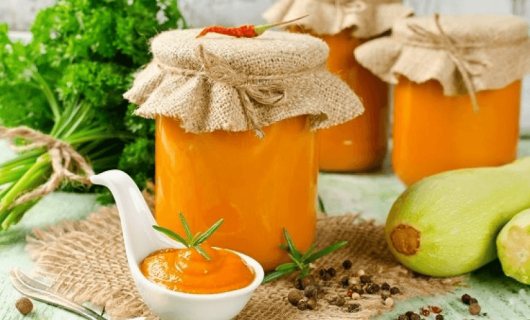
The arrival of a new member in the family is one of the most important events. Now new parents are adapting their lives to this little bundle, especially mom. Even during pregnancy, she felt the “charm” of restrictions associated with nutrition and medication. When the baby was born the situation did not change, it even got tougher. After all, everything that mother eats will be given to her baby. What foods can you eat, how much and how? Vegetables, fruits - what is allowed? What about squash caviar when breastfeeding, because it is made from a “harmless” vegetable, but it also contains other components.
Composition of squash caviar
Zucchini dishes are interesting for their diversity and, accordingly, the components included in them. In addition to the vegetable under study, it includes:
- carrot;
- onion;
- tomatoes;
- sunflower or olive oil.
Season with salt, granulated sugar, black pepper and vinegar (it is not advisable to consume foods with vinegar when breastfeeding). Zucchini, you can replace zucchini.
Is it possible to have squash caviar while breastfeeding?
Zucchini is indeed included in the list of safe foods. It is not for nothing that it is included among the vegetables from which the first complementary foods for babies are prepared. Rich in valuable elements and vitamins.
Nutritionists recommend including it in a woman’s diet when breastfeeding, since it is easily digestible and does not cause allergic reactions or digestive disorders.
In addition, it is low-calorie, which is very pleasing to women who are trying to get rid of extra pounds accumulated during pregnancy. What about dishes made from it? Is it possible to eat squash caviar while breastfeeding?
Important! The vegetable is safe to feed after undergoing heat treatment.
Zucchini has a neutral taste, so it goes well with other vegetables in ready-made dishes. One of them is caviar. When can you start using it? Is it possible to eat squash caviar in the first month of lactation or is it better to wait? The dish contains tomatoes, which are allergens.
Therefore, caviar prepared according to the classic recipe should be introduced into the diet after the second month of the baby’s life. At the same time, follow the rules for introducing a new product into the diet.
If you wish, you can try it earlier, but then it is recommended to change the classic recipe and exclude tomatoes from it.
Considering that the mass-produced product contains chemical additives, caviar consumed during breastfeeding must be homemade.
Benefits during lactation
It is worth remembering that during heat treatment most vitamins are lost, but some useful components remain. Quickly prepared steamed or boiled vegetables retain maximum nutrients.
When preparing the dish, long stewing is used. But this does not mean that it is not useful.
In addition to preserved micro and macroelements, it contains a high proportion of fiber, which is important for a woman’s normal digestion, especially in the postpartum period, when the likelihood of constipation increases.
Considering the beneficial qualities of the products included in its composition, caviar contributes to:
- increasing the elasticity of blood vessels;
- freeing the body from harmful cholesterol;
- strengthening the nervous system, increasing stress resistance, reducing the likelihood of depression, which is extremely important in the postpartum period;
- normalization of metabolism.
Possible harm to nursing mothers
You can talk about the dangers of caviar only if it is prepared industrially. It is this dish that contains prohibited ingredients: preservatives, stabilizers, thickeners, flavor enhancers.
It contains tomatoes; they are allergens, so caviar is introduced into the diet in accordance with the rules for introducing new products.
In addition to individual intolerance to some components, it is not recommended for use in case of malfunctions:
- Gastrointestinal tract;
- kidney;
- Bladder.
When and how to introduce it into the diet
When introducing vegetable caviar into the menu, a nursing mother must follow certain recommendations:
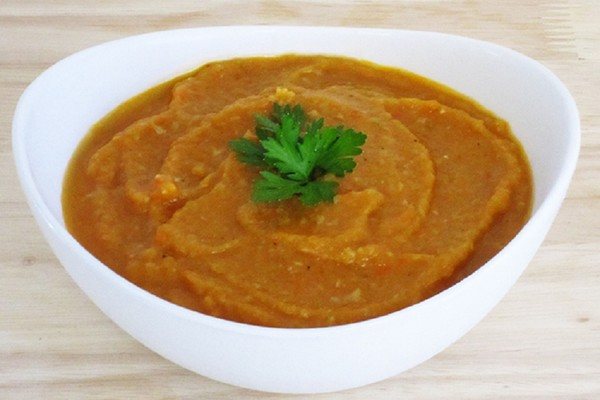
- The dish is introduced 10-14 days after the birth of the child. Some doctors recommend waiting until the baby reaches two months, only then diversifying the menu with a zucchini snack;
- First, you need to try each vegetable component of this preservation separately, having previously heat-treated it;
- first meal – up to two tablespoons of the dish;
- in the absence of allergic reactions on the part of the baby, the portion can be increased to 150-400 g per week.
Squash caviar in the diet of a nursing mother: benefits and harms
After the birth of a baby, the nursing mother has a huge responsibility for his proper nutrition.
In the first months of life, as a rule, the baby feeds exclusively on breast milk, so a nursing mother should carefully consider her diet during this period. The list of products that do not pose a danger to a newborn is very limited.
In the process of further formation of the baby’s digestive system and the ability to produce the required amount of enzymes, the list of permitted products may be expanded.
One of the products that is not dangerous for the baby is zucchini. Since it contains many useful substances and vitamins, it is even used as the first food for six-month-old babies. Zucchini is also useful for women during lactation, because it does not cause allergic reactions and does not disrupt the functioning of the digestive system.
But only boiled or stewed vegetables are considered safe. Since zucchini does not have a distinct taste, it is mainly used in combination with other products. In this article we will look at whether it is possible to include caviar made from zucchini in the menu of a nursing mother.
The benefits of squash caviar for a nursing woman
Squash caviar is a dish that is prepared from several ingredients. In addition to the zucchini itself, carrots, tomatoes, onions, turnips and vegetable oil are used.
To improve the taste, caviar is seasoned with granulated sugar, salt, vinegar and ground black pepper.
Due to the content of a large amount of vitamins and beneficial microelements in zucchini, it has a number of beneficial properties for breastfeeding:
- vitamin B has a positive effect on the nervous system;
- vitamin C helps strengthen the immune system, weakened during gestation and childbirth;
- vitamin A has a positive effect on the condition of the skin, hair and nails;
- the presence of sodium and potassium helps to normalize the water balance in the female body and eliminates the appearance of edema;
- magnesium ensures the normal functioning of the cardiovascular system;
- calcium is a component that strengthens the baby’s bones and promotes normal metabolism in a nursing woman.
Zucchini is a low-calorie vegetable that helps a nursing mother reduce the weight gained during pregnancy.
The main advantage of this product is the large amount of fiber it contains, which promotes normal digestion.
Harm
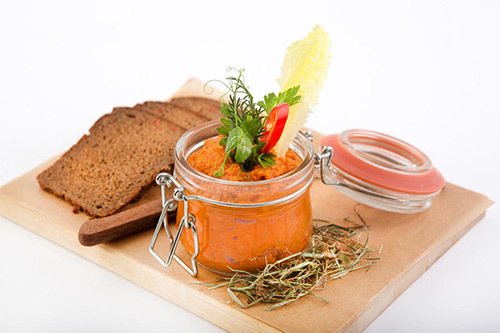
Zucchini has many beneficial properties, but a woman during lactation should not overuse this vegetable, as it can negatively affect the body of a nursing mother. Zucchini is a product that has a strong diuretic effect. This promotes the removal from the body, along with toxins and wastes, of useful substances necessary for normal life. One of these elements is potassium, the lack of which in the body can cause heart failure. Also, eating zucchini can cause the following problems:
- pain in the epigastric area caused by the acid contained in the raw vegetable;
- diarrhea in a nursing mother;
- intestinal colic, bloating and liquid stool in a newborn;
- the appearance of an allergic reaction.
All these problems are possible only if this product is abused. It is not recommended for a nursing mother to eat more than 300 grams of zucchini at one time.
Store-bought squash caviar in the diet of a nursing woman

Squash caviar, which is sold in our stores, is a canned product. And women are not recommended to eat them during breastfeeding. This is due to the presence of various preservatives, acetic acid, emulsifiers, artificial flavors and coloring agents in store-bought canned food.
All these components, penetrating into mother's milk, harm the health of the baby. The baby may develop an allergy, resulting in a skin rash, swelling and redness of the mucous membranes.
The presence of preservatives and artificial ingredients can cause disturbances in the baby's digestive system and contribute to the occurrence of problems such as intestinal colic and flatulence.
In this regard, it is not recommended for a nursing mother to consume store-bought squash caviar.
It's better to cook it yourself.
Please note that tomatoes, which are one of the components of squash caviar, are foods that cause allergies in your baby. Before introducing homemade squash caviar into her diet, a nursing mother should check whether the child has an individual intolerance to the components of this product.
Tomatoes should be introduced into the menu of a nursing mother only when the baby is two months old. Therefore, squash caviar should be included in her diet no earlier than this period.
How to prepare healthy squash caviar at home
The vegetable snack recipe is quite simple. Prepare 0.5 kg of tomatoes, carrots, onions and 2 kg of zucchini. Vegetables must be peeled, washed and chopped either in a meat grinder or blender. Pour the resulting mass into a saucepan, adding 100 ml of vegetable oil.
Simmer the mixture over low heat for 60 minutes. After this, add three tbsp. spoons of vinegar, two or three tbsp. spoons of homemade tomato paste, tbsp. a spoonful of salt, 200 g of sugar and season with ground black pepper. Stir and cook for another 15 minutes. After this, cool and transfer to a glass container. Store in the refrigerator for no more than three days.
- Related Posts
- Rusks during breastfeeding: a healthy treat, or taboo
- Is it possible to drink mineral water while breastfeeding?
- Eating duck while breastfeeding: panacea or taboo
« Previous entry
Recipe for making caviar from zucchini
The recipe for preparing the dish at home is extremely simple. Necessary:
- zucchini – 1.7 kg;
- carrots – 560 g;
- onion – 470 g;
- tomatoes – 540 g;
- salt;
- black pepper;
- oil for sautéing – 35 ml.
Cooking diagram:
- Wash the zucchini, remove the stems, cut into cubes.
- Peel the onions and carrots, chop finely.
- Pour oil into a deep container, heat and sauté carrots and onions.
- Add zucchini. Add salt and pepper to taste. You can add a little granulated sugar.
- Wash the tomatoes, dry them, cut them into cubes and add them to the vegetable mixture.
- Continue sautéing.
- Pass the resulting mass through a meat grinder or grind it using a blender, place it back in the container and simmer for about a quarter of an hour.
- After cooling, transfer to a clean, dry container and store in the cold for no more than 2-3 days.
